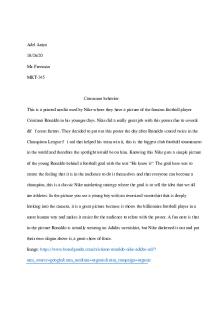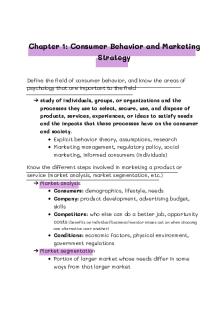Chapter 1 - Summary Consumer Behavior: Buying Having and Being PDF

| Title | Chapter 1 - Summary Consumer Behavior: Buying Having and Being |
|---|---|
| Author | Andrew Hachey |
| Course | Consumer Behaviour |
| Institution | Concordia University |
| Pages | 6 |
| File Size | 114.3 KB |
| File Type | |
| Total Downloads | 74 |
| Total Views | 141 |
Summary
Chapter notes summary...
Description
CHAPTER 1: AN INTRODUCTION TO CONSUMER BEHAVIOR 1) Consumer behaviour is a process (consumption process) 2) Marketers must understand needs of different consumers 3) Marketers can influence consumers 4) Consumer behaviour can have a “dark side” (addiction) 5) Marketers use both primary and secondary research to better understand the consumer, and how they consume (before, during, and after) What is Consumer Behavior? Consumption process: Issues that influence the consumer before (research), during (experience, process, meaning of consumption), and after the purchase (use, disposal).
Study of the processes involved when individuals or groups select, purchase, use or dispose of products, services, ideas, experiences to satisfy needs and desires
Attitudes are difficult to change, situational factors influence during, satisfaction and expectations met – do they influence others?
Consumer Behavior is a Process
Field of consumer behavior used to be often referred to as buyer behavior
It is an ongoing process, not just what happens in the moment
Exchange: two or more organization or people give and receive something of value
CONSUMERS’ IMPACT ON MARKETING STRATEGY
Understanding consumer behavior is good business
Consumer response is ultimate test of whether marketing strategy will succeed
Discover needs (CB) satisfy needs (4Ps)
Segmenting Consumers
Market segmentation: identifies groups of consumers who are similar to one another in one or more ways and then devises strategies that appeal to groups
80/20 rule: 20% of users account for 80% of percent of sales
Demographics: stats that measure observable aspects of a population
CHAPTER 1: AN INTRODUCTION TO CONSUMER BEHAVIOR Birth rate, age, income, geographic
Psychographics: differences in consumers’ personalities, attitudes, values, lifestyles Lifestyles: Beyond Demographics (what we like to do in our spare time)
Relationship marketing: Building Bonds w/ Consumers
Making an effort to interact with customers on a regular basis, giving them reasons to maintain a bond with a company over time
Database marketing: tailor marketing activities based on collected info
Big data: the collection and analysis of extremely large datasets.
MAKETING’S IMPACT ON CONSUMERS Marketing and Culture -
Our views of the world can be affected by marketers. Be responsible.
Popular culture: consists of the music, movies, sports, books, celebrities and other entertainment consumed by the mass market Product and inspiration for marketers
Consumer generated content: consumers themselves voice their own opinion about products, brands, companies on blogs, podcasts, social networking sites
The Meaning of Consumption
People often buy products not for what they do but for what they mean – brand personality
Emphasizes the role that products play in our lives go way beyond the tasks they perform
The Global Consumer
U-commerce: ubiquitous networks, whether in the form of wearable computers or customized ads beamed to us on our cell phones
RFID tag: contains computer chip and tiny antenna that lets chip communicate with network
Virtual Consumption
CHAPTER 1: AN INTRODUCTION TO CONSUMER BEHAVIOR C2C with review sites (rotten tomatoes, tripadvisor, etc)
Digital native: students that have grown up wired in a highly networked world
Horizontal revolution: each of us communicate with huge numbers of people by a click on a keypad, characterized by the prevalence of social media
Social media: online means of communication, conveyance, collaboration, cultivation among interconnected and interdependent networks of people, communities, orgs
Synchronous interactions: interactions that occur in real time
(facebook)
Asynchronous interactions: ones that don’t require all participants to
respond immediately (text a friend, get an answer the next day)
Culture of participation: belief in democracy, ability to interact freely with others
Open access to venues that allow users to share content
Social media allows this
MARKETING ETHICS AND PUBLIC POLICY Business Ethics: rules of conduct that guide actions in the marketplace
Standards against which most people in a marketplace judge what is right,
wrong, good, or bad
Ethical business is “good business”
Bribery is wrong
Biggest problem today, Behavioural marketing.
Prescribing Ethical Standards of Conduct: Guidelines of conduct
Disclosure of all substantial risks associated with product/services
Identification of added features that will increase the cost
Avoidance of false or misleading advertising
Rejection of high-pressure or misleading sales tactics
Prohibition of selling or fundraising under the guise of conducting market
research
NEEDS AND WANTS: DO MARKETERS MANIPULATE CONSUMERS?
CHAPTER 1: AN INTRODUCTION TO CONSUMER BEHAVIOR Criticism of marketing is that we convince people they need thing Do Marketers Create Artificial Needs?
Needs: past, present, future. Constantly evolving. They are already there; we simply recommend ways to satisfy it
Are Advertising and Marketing Neceessary
Important tools to manipulate masses, according to john Kenneth
According to textbook, products are designed to meet existing needs, and advertising merely helps to communicate the product’s availability
Public Policy and Consumerism
The welfare of the consumer is protected by many laws at the federal, provincial and municipal levels
Regulation protects consumers from unfair business practices and protects the broad interests of society
Labeling of harmful products and prohibition of sales of certain substances (melatonin) are meant to protect the health of Canadians.
Lead paint from Chinese toys pulled off the shelves
Consumer Activism and its Impact on Marketing
Culture jamming: aims to disrupt efforts by the corporate world to dominate our cultural landscape
Corporate social responsibility (CSR): choose to protect or enhance positive social and environmental impacts as you go about business activities. Trends: align social impact with business strategy. Shift from CSR to Social Impact
Corporate giving: some marketers who donate money to good causes
Cause-related marketing: promising donations to charity as purchase incentives
Green marketing: offer products in ways that are less harmful to environment
Social marketing: marketing techniques normally employed to sell beer or detergent to encourage positive behaviors such as increased literacy or discourage negative activities such as drunk driving
CHAPTER 1: AN INTRODUCTION TO CONSUMER BEHAVIOR Transformative Consumer Research (TCR): researchers organizing to not only study but to rectify what they see as pressing social problems in the marketplace Consumers are not objects of research but collaborators who work with
researchers to realize this change
THE DARK SIDE OF CONSUMER BEHAVIOR Addictive Consumption Consumer addiction: physiological or psychological dependency on products
or services. Ex: alcohol, drugs, cigarettes, social media, etc.
Compulsive Consumption
People who shop because they feel compelled to do so because shopping is pleasurable for them
Compulsive Consumption: repetitive shopping, often excessive, tension, anxiety, depression, boredom Different from impulse buying, which will be discussed later
Products control the consumer when someone is a compulsive consumer
Three common characteristics of negative or destructive consumer behavior
Behavior is not engaged by choice
Gratification derived from the behavior is short-lived
The person experiences strong feelings of regret or guilt afterwards
An example is gambling
Shrinkage: industry term for inventory and cash losses from shoplifting and
Illegal Activities: Consumer Theft
employee Frequently stolen products are athletic shoes, logo, brand name apparel, jeans
Anticonsumption
Abuse of exchange policies
CHAPTER 1: AN INTRODUCTION TO CONSUMER BEHAVIOR Anticonsumption: destructive consumer behavior, rebelling against the idea of consumption itself Product tampering, innocent consumers are hurt, graffiti on subways, destroying
billboards
HOW DO WE FIND OUT ABOUT CONSUMERS? THE ROLE OF CONSUMER RESEARCH
Primary research: data collected by the researcher. Goal: to uncover consumer insights.
Secondary research: data collected from a pre-existing source to answer a different research question.
Primary Research
Survey: set of questions posed by the researcher
Focus Groups: small moderated group sessions
Interviews: one-to-one interaction with the researcher and subject
Observational Research: behaviors are directly observed in a natural context or controlled setting. Ethnographic: real world.
Qualitative Research:
Storytelling (consumer tell researcher about experience with product)
Role-playing (consumers put themselves in a particular role)
Photos or pictures
Diary
Projective techniques (presentation of ambiguous, unstructured object)
Experimental Research
Experiments: used when researchers want to make cause-and-effect claims
Random assignment: put participants into groups or experimental conditions by
Experiments
random
Independent variable: variable that researcher manipulates
Dependent variable: variable that researcher measures
Starbucks Unicorn Drink Strategy: timely limited time trend (photos)...
Similar Free PDFs

Consumer Buying Behavior
- 3 Pages

Readings Summary - Consumer Behavior
- 62 Pages

Chapter 4 - Consumer Behavior
- 8 Pages

CONSUMER BUYING BEHAVIOUR
- 6 Pages

Consumer behavior
- 5 Pages

Consumer Behavior
- 33 Pages
Popular Institutions
- Tinajero National High School - Annex
- Politeknik Caltex Riau
- Yokohama City University
- SGT University
- University of Al-Qadisiyah
- Divine Word College of Vigan
- Techniek College Rotterdam
- Universidade de Santiago
- Universiti Teknologi MARA Cawangan Johor Kampus Pasir Gudang
- Poltekkes Kemenkes Yogyakarta
- Baguio City National High School
- Colegio san marcos
- preparatoria uno
- Centro de Bachillerato Tecnológico Industrial y de Servicios No. 107
- Dalian Maritime University
- Quang Trung Secondary School
- Colegio Tecnológico en Informática
- Corporación Regional de Educación Superior
- Grupo CEDVA
- Dar Al Uloom University
- Centro de Estudios Preuniversitarios de la Universidad Nacional de Ingeniería
- 上智大学
- Aakash International School, Nuna Majara
- San Felipe Neri Catholic School
- Kang Chiao International School - New Taipei City
- Misamis Occidental National High School
- Institución Educativa Escuela Normal Juan Ladrilleros
- Kolehiyo ng Pantukan
- Batanes State College
- Instituto Continental
- Sekolah Menengah Kejuruan Kesehatan Kaltara (Tarakan)
- Colegio de La Inmaculada Concepcion - Cebu









